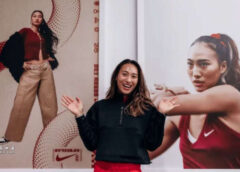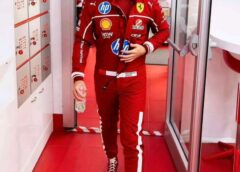2022年2月9日,《纽约时报》在国外社交媒体上推送了由体育记者安德鲁·凯(Andrew Keh)在北京冬奥会现场采写的一篇关于美国花样滑冰代表队的文章。
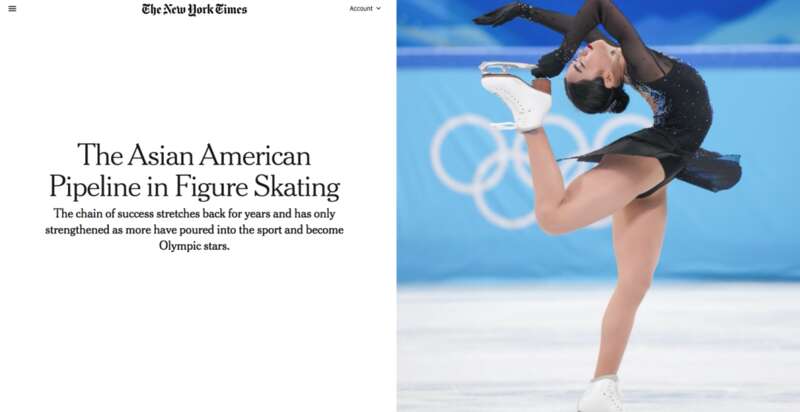
凯发布在纽时上的文章。
这篇文章从退役的华裔花滑运动员陈婷婷的感慨写起,讲述曾经在美国运动界毫无存在感的亚裔是如何在三十年的时间内,在花样滑冰领域实现“逆袭”,占据美国花样滑冰队“半边天”的故事。文章通过采访多名现役运动员和老运动员,记录了新老运动员之间的激励和传承。他们从感到边缘化甚至被歧视,到逐渐找到文化自信,勇敢的抵制各种区别对待,也战胜了网暴压力取得令人瞩目的成绩。
为了推送这篇用体育新闻的形式讨论社会话题的报道,纽时连发了四条推特,第一条是文章结尾的一句话:“长期以来,亚裔一直苦于在美国流行文化中缺乏代表性。因此,对于这些花滑选手来说,看到顶尖运动员身上反映出自己的元素,可能是一种激动人心的体验。”
这条推文并没有引起什么波澜,但是后来的一条却引发了轩然大波,从网友到政客,从社交媒体到机构媒体,从美国到中国,那条推文中的一个词组成功引来了铺天盖地的争议。那条推文写道:
“亚洲人约占美国人口的 7%,但在各个级别的溜冰场和比赛中,从东海岸到西海岸,亚洲人的代表显而易见的高于人口比例(vividly overrepresented)。逐渐地,他们改变了一项运动,直到 1990 年代,这项运动几乎都是白人。”
在中文媒体中,vividly overrepresented这个词多被翻译为“明显过高”,还有媒体进一步将文章中的“亚裔”替换成“华裔”,直指纽时“反华”;而在英文社交媒体上,这个词本身也引来了诸多吐槽。多名网友留言道:“你们怎么不报道NBA(美国职业篮球联赛)里面有哪些种族vividly overrepresented了呢?”还有更多人直斥其“种族主义”,其中包括共和党联邦参议员泰德·科鲁兹(Ted Cruz)。
作为支持1月6日国会山“夺权”行动的右派领袖之一,科鲁兹长期被左派大本营媒体《纽约时报》口诛笔伐,其评论版不吝尖锐措辞,指责他为“美国有史以来最没良心的政客”“那些可耻的政变策划者共和党人”等等。这次,科鲁兹终于抓住机会,他转发了纽时的推特,评论说:“自由主义者拥抱种族主义,尤其是针对亚裔美国人。《纽约时报》抱怨亚裔在滑冰项目里人明显超比例了。”
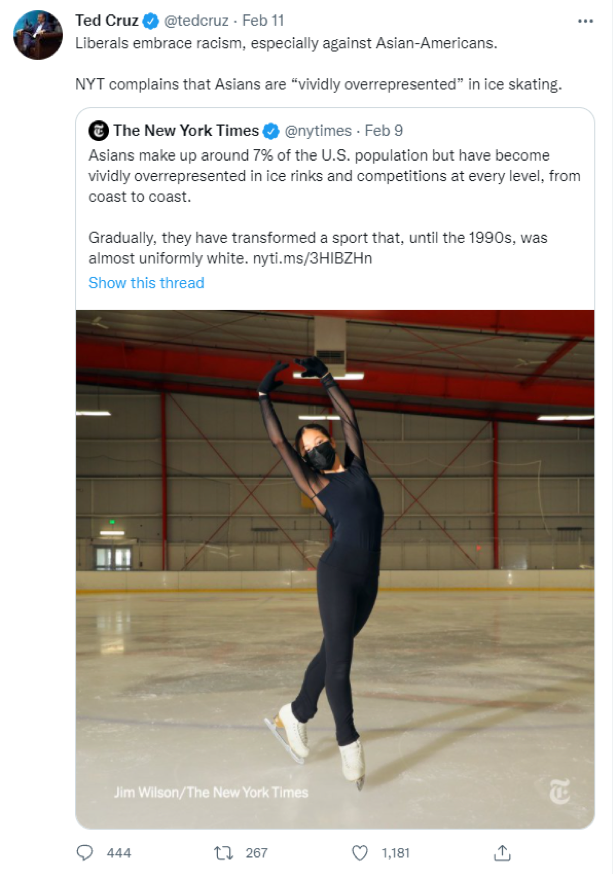
科鲁兹的社交媒体截图
激烈的讨论持续了一个多星期,直到昨天,纽约市居民联盟还在发文谴责,要求《纽约时报》道歉。此前,《纽约时报》等媒体报道了在纽约重点打造的特殊高中尖子班里面,亚裔的人数超过人口比例,也是用的overrepresented这个词,并且引发了一些政客当机立断提议要取消特殊高中考试,按照人口比例分配入学名额以照顾弱势族裔的风波。纽约市居民联盟本身也是一群以华裔为主的家长为了捍卫特殊高中考试而成立。
除了教育资源之外,在美国社会的其他多个领域,不同种族选民群体之间的资源竞争关系也在日渐紧张,使得客观描述人口比例在统计上的“超高”或者“超低”成了可能直接带来一系列后果的特殊词汇。尤其是对持有不同政见的人来说,这个敏感词有了见仁见智的不同指向和含义。
“作者自己也是亚裔,我不认为他是在歧视亚裔。”
“我怀疑你们有没有读原文?”
也有支持者对纽时记者表达支持,尽管在评论区如潮的谴责声中,这样的评论并不多。
“我完全能够理解,”这篇报道的作者凯在评论区回应说:“推特上已经不止一次发生这种情况,一个词在推文中的使用没能表达出原文中的意思。读了原文的人们可能有不一样的感受。”他并解释说:“我与多名亚裔美国社会学家对话时听到‘比例过高’(overrepresented)这个词,然后使用了它。从字面意思看,这只意味着参与率与人口统计数据不成比例,不含任何批判色彩。”
“比例超高这个词或许是个统计学上的中性词,但是在现在的社会环境下,它已经承载了太多的含义。作为面对大众的写作者来说,应该考虑用更好的词来表达这个意思。”网民Chris Young评论说。
附:《纽约时报》报道中英文对照原文
亚裔美国人撑起美国花样滑冰“半边天”The Asian American Pipeline in Figure Skating
BEIJING — Tiffany Chin scanned the arena at the U.S. Figure Skating Championships last month and marveled at how things had changed.
北京——在上个月的美国花样滑冰锦标赛上,陈婷婷扫视全场,感叹变化之大。
Chin won the national title in 1985. She was a happy-go-lucky teenager back then, but savvy enough to realize that the winners who had come before her had not looked like her, that few people in the rinks where she skated ever did.
1985年,陈婷婷获得全国冠军。那时她还是个无忧无虑的少女,但她的见识也足以让她意识到,之前的获胜者都和她长得不一样,在这个冰场里几乎没什么人和她一样。
The scene last month was different. Asian American skaters populated the singles and pairs and ice dancing competitions. They appeared up and down the standings in the senior and junior contests. And by the end of the week, they filled the roster of the Olympic team.
上个月的情况则有所不同。亚裔美国滑冰选手占据了单人滑、双人滑和冰舞比赛。他们在各级别比赛排行榜上起起落落。周末,美国奥运花滑代表队的名单上出现的也全是他们。
For the second consecutive Winter Games, four of the six figure skaters who arrived to represent the United States in the singles events were Asian American: Karen Chen, Nathan Chen, Alysa Liu and Vincent Zhou. A fifth Asian American skater, Madison Chock, is competing in the ice dancing event.
在连续两届冬奥会代表美国参加单人比赛的六名花样滑冰选手中,有四名是亚裔美国人:陈楷雯、陈巍、刘美贤和周知方。第五名亚裔美国滑冰选手麦迪逊·乔克将参加冰舞比赛。
“There are so many,” Chin said. “And that is so exciting.”
“好多啊,”陈婷婷说。“太让人兴奋了。”
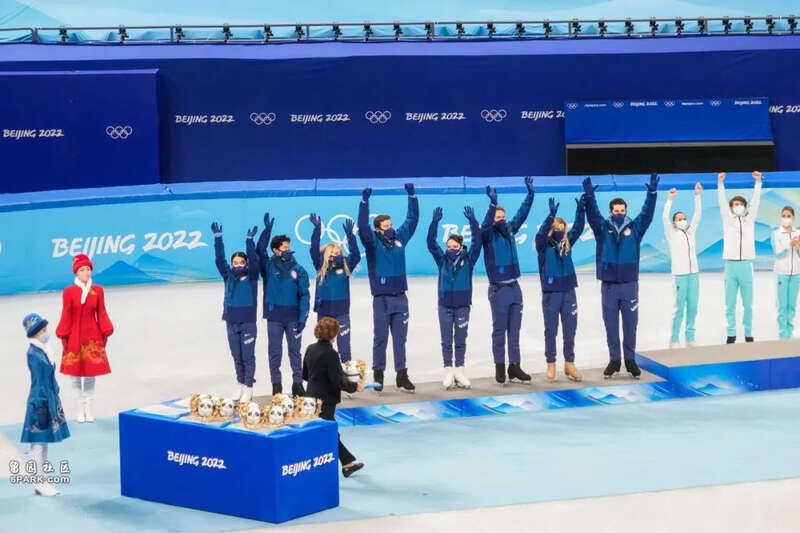
美国选手陈楷雯、陈巍和麦迪逊·乔克在团体项目中获得银牌。(由于新冠病毒检测结果为阳性,周知方没有出席颁奖仪式。) CHANG W. LEE/THE NEW YORK TIMES
In the United States, a country where Asians and sports are not often intertwined in the popular imagination, figure skating is now plainly an Asian American sport. Asians make up around 7 percent of the American population but have become vividly overrepresented in ice rinks and competitions at every level, from coast to coast.
在美国,大众通常不会把亚裔与体育运动联系在一起,但花样滑冰现在显然是一项亚裔美国人的运动。亚裔约占美国人口的7%,但在美国各地的冰场和比赛中,亚裔的比例明显高于其他族裔。
Gradually, they have transformed a sport that, until the 1990s, was almost uniformly white. They have infused competitions with music that draws from their Asian heritage, bolstered a pipeline that could solidify their hold on the sport and, in a climate of anxiety about anti-Asian violence, navigated the perils of hate on social media while insisting on expressing their roots.
渐渐地,他们改变了这项直到1990年代几乎都属于白人的运动。他们在比赛中注入了来自亚裔传统的音乐,加强了可以巩固他们在这项运动中地位的人才输送渠道,在对反亚裔暴力感到焦虑的气氛中,他们克服社交媒体上的仇恨,坚持表达他们自己的根源。
“I think representation is really important,” said Nathan Chen, a Chinese American who was also a member of the Olympic team in 2018, when seven of the 14 skaters were Asian American. “So to continue seeing faces that kind of look like yours on TV doing really cool things, I think, is still useful to a young kid.”
“我认为代表性真的很重要,”华裔美国人陈巍说。他也是2018年冬奥会代表队的成员,当时14名花滑选手中有7人是亚裔美国人。“所以,我认为,一直能在电视上看到像你们这样的面孔做出非常酷的事情,对一个年轻的孩子来说仍然是有用的。”
Amid the various factors behind this phenomenon, almost every Asian American skater mentions being inspired by a chain of early pioneers.
在这一现象背后的各种原因之中,几乎每个亚裔美国花滑选手都提到自己受到了一批早期先驱者的启发。
Chin provided such a spark for Kristi Yamaguchi, four years her junior, who recalled watching Chin whenever she came to the Bay Area, where Yamaguchi grew up, marveling at her technique and even asking once for her autograph.
陈婷婷给比她小四岁的克里斯蒂·山口带来了这样的火花。山口回忆说,每当她来到自己长大的旧金山湾区,都会去看陈婷婷,陈婷婷的技巧令她惊叹,她甚至有一次还向陈婷婷要签名。
“I always looked up to her,” said Yamaguchi, a two-time world champion, who became a household name after winning a gold medal at the 1992 Games. “There was definitely that kinship, that inherent connection, because she is Asian American.”
“我一直很仰慕她,”山口说。山口曾两获世界冠军,在1992年奥运会上赢得金牌后,她成了家喻户晓的人物。“肯定是有那种亲近感,那种内在的联系,因为她是亚裔美国人。”
Liu, 16, a two-time U.S. champion, began skating, in part, because her father, Arthur Liu, had become such a big fan of Michelle Kwan — a two-time Olympic medalist (1998, 2002), five-time world champion and nine-time national champion — after immigrating to the United States from China three decades ago.
16岁的刘美贤曾两获得美国滑冰冠军,她之所以开始滑冰,部分原因是她的父亲刘俊30年前从中国移民到美国后,就成了关颖珊的超级粉丝。关颖珊曾于1998年和2002年两获奥运奖牌,五获世界冠军,九获全国冠军。
“I watched figure skating all the time,” he said. “When I had Alysa, my office was two blocks away from the Oakland Ice Center, and I figured, let’s see if she likes it.”
“我一直在看花样滑冰,”刘俊说。“阿莱莎(刘美贤的英文名——译注)出生的时候,我的办公室离奥克兰冰雪中心只有两个街区,我想,看看她会不会喜欢吧。”
In some ways, it has seemed like a matter of being in the right place at the right time.
在某些方面,这似乎是天时地利的结果。
The success of Yamaguchi and Kwan came at a time when figure skating was near the peak of its popularity in the United States (it has faded considerably since then) and on the heels of a surge in new rinks around the country.
克里斯蒂·山口和关颖珊获得成功的时候,花样滑冰在美国的受欢迎程度正接近顶峰(从那以后就开始大幅下降了),而且全国各地的新建冰场也在激增。
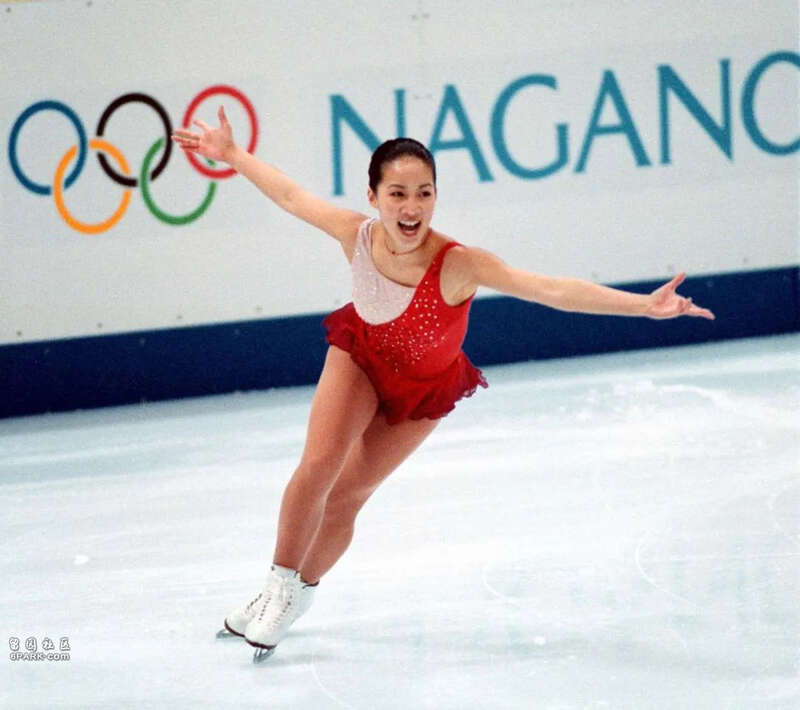
关颖珊在1998年长野奥运会上表演短节目。CHANG W. LEE/THE NEW YORK TIMES
Chin, Yamaguchi and Kwan all grew up in California, and the state, with its considerable Asian population, remains a center of gravity for the sport today. Karen Chen, Chock, Liu and Zhou, for instance, were all born in California.
陈婷婷、克里斯蒂·山口和关颖珊都是在加州长大,那里有相当多的亚裔人口,如今仍是这项运动的重心。陈楷雯、麦迪逊·乔克、刘美贤和周知方都出生在加州。
When Kwan opened an ice rink in Artesia, Calif., in 2005, it quickly became a magnet for Asian families from the area. Chin, who coaches now in Southern California, said around 40 percent of her pupils were Asian. And Californians are not only representing America: Zhu Yi (also known as Beverly Zhu), who is from Los Angeles, is competing for China this year after winning the U.S. novice title in 2018.
2005年,关颖珊在加州阿特西亚开了一家溜冰场,很快吸引了该地区的亚裔家庭。目前在南加州当教练的陈婷婷说,她的学生中大约有40%是亚裔。加州人不仅代表美国参赛:来自洛杉矶的朱易(又名贝弗莉·朱)在2018年赢得美国少年赛冠军后,今年将代表中国参赛。
Other explanations — that Asians excel because they tend to have smaller bodies or because their parents are demanding, so-called tiger parents — are often floated, including by some Asian Americans, but experts tend to dismiss such theories outright.
其他的解释也经常被提起——亚裔之所以优秀,是因为他们的身材往往更小巧,或者是因为他们的父母要求更严格,也就是所谓的虎爸虎妈——一些亚裔美国人自己也这样说,但专家倾向于直接否定这些说法。
“Every race has body types that would be successful in figure skating,” said Christina Chin, who teaches a sports sociology course at Cal State Fullerton. “It’s the cultural acceptance, the societal pressures or opportunities, the structural forces and institutions that make it possible.”
“每个种族都有能在花样滑冰中取得成功的体型,”加州州立大学富勒顿分校教授体育社会学课程的克里斯蒂娜·陈说。“是文化接受度、社会压力或机会、结构性力量和制度使其成为可能。”
People do tend to agree on one factor in explaining why Asian Americans have broken through in figure skating, while other minority groups in the United States have not: Figure skating is expensive, and East Asians, as an immigrant group, have the highest average household income in the country.
在解释为什么亚裔美国人在花样滑冰方面取得突破,而美国其他少数族裔却没能做到时,人们倾向于认同一个因素:花样滑冰花费昂贵,而东亚人作为移民群体,在美国拥有最高的平均家庭收入。
Asians have long struggled with a lack of representation in American popular culture. For these skaters, then, seeing elements of themselves mirrored in top athletes could be a soul-stirring experience.
长期以来,亚裔一直苦于在美国流行文化中缺乏代表性。因此,对于这些花滑选手来说,看到顶尖运动员身上反映出自己的元素,可能是一种激动人心的体验。
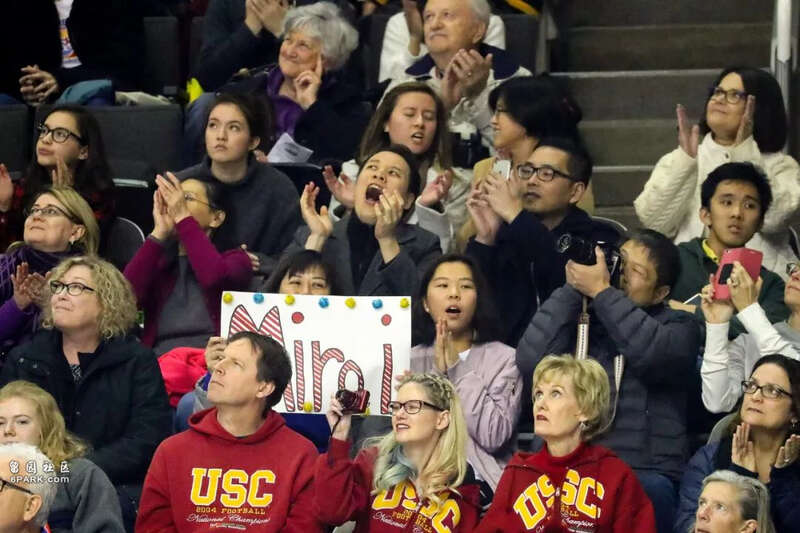
在2018年美国花样滑冰锦标赛上,长洲未来的得分让粉丝们惊叹不已。CHANG W. LEE/THE NEW YORK TIMES
Mirai Nagasu, a former national champion and two-time Olympian (2010, 2018), grew up working at her parents’ Japanese restaurant, where they eked out enough money to pay for her lessons. Nagasu laughed remembering how much it meant to her, as a young skater, to learn that Kwan’s parents had owned a restaurant, too. (Chin’s parents also owned a Chinese restaurant, and Liu’s father worked in one before she was born.)
前国家冠军和两届奥运会选手(2010年、2018年)长洲未来从小就在父母的日本餐馆工作,他们靠这家餐馆勉强攒够了钱支付她的课程。长洲未来笑着回忆起,当她还是一名年轻滑冰运动员时,得知关颖珊的父母也开过餐馆,这对她来说非常重要。(陈婷婷的父母也开了一家中餐馆,刘美贤的父亲在她出生前也曾在餐馆工作。)
Naomi Nari Nam, who won a silver medal at the 1999 national championships, noted that the rise of Asian American participation had also coincided with the success of skaters from East Asia, like Yuna Kim of South Korea.
曾在1999年全国锦标赛上获得银牌的娜奥米·纳里·南指出,亚裔美国人参与花滑人数的上升与东亚运动员取得成功(如韩国的金妍儿)发生在同一个时期。
“When I started skating, I was the one out of two Asian skaters in my rink, in Costa Mesa, Calif.,” said Nam, whose success led to an appearance on “The Tonight Show” at age 13 and a run of television appearances and commercials in Korea. “I coach now in Lakewood, Calif., and around 90 percent of my clientele is Asian or half Asian.”
“我刚开始滑冰的时候,在加州科斯塔梅萨的溜冰场里,我是两名亚裔滑冰选手中的一名,”娜奥米·南说。她的成功让她在13岁时登上了《今夜秀》(The Tonight Show)节目,并在韩国一系列电视节目和广告中出现。“我现在在加利福尼亚州的莱克伍德当教练,我的客户中大约90%是亚裔或半亚裔。”
Still, the sport was not always accommodating to them.
尽管如此,这项运动并不总是包容他们。
When Chin skated, she was often called “China Doll” by commentators and journalists. Articles from the time refer to her “porcelain complexion” and “Oriental roots.” She was called a “siamese cat” and “unemotional” and an “exotic beauty.”
陈婷婷滑冰时,经常被评论员和记者称为“中国娃娃”。当时的文章提到了她的“瓷器肤色”和“东方根基”。她被称为“暹罗猫”、“不带情绪”,是个“异国情调的美女”。
Nam was placed in an etiquette class by her coach so she could learn how to interact with the predominantly white officials and judges who could decide her fate in skating.
娜奥米·南被她的教练安排上礼仪课,这样她就可以学习如何与白人占主导的官员和法官互动,这些人可以决定她滑冰事业的命运。
“He knew that it was a different culture,” Nam said.
“他知道这是一种不同的文化,”南说。
Skaters said that while explicit racism inside figure skating felt rare, many acknowledged that they received racist comments on social media. Alysa Liu learned over time to tune out harassing messages. But some incidents, in a time when violence and hate against Asian Americans have increased, have been harder to ignore. Liu, who has spoken about her growing awareness of social issues, called her father one recent night, struggling to sleep after reading about the shooting of a 71-year-old Chinese man in Chicago.
花样滑冰运动员表示,虽然这项运动中很少见到明显的种族主义,但许多人承认他们在社交媒体上收到了种族主义评论。随着时间的推移,刘美贤学会了对骚扰信息充耳不闻。但在针对亚裔美国人的暴力和仇恨增加之际,一些事件仍难以忽视。刘美贤谈到她对社会问题的意识日益增强,最近一天晚上,她在读到一名71岁的中国男子在芝加哥被枪击后难以入睡,给父亲打了电话。
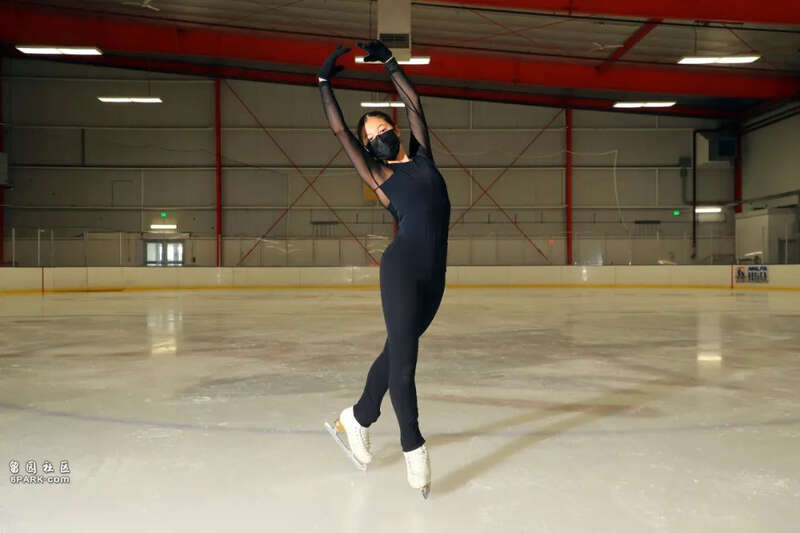
刘美贤在加州奥克兰训练。JIM WILSON/THE NEW YORK TIMES
“She was crying,” Arthur Liu said. “Crying hard.”
“她在哭,”亚瑟·刘(音)说。“哭得很厉害。”
At the 2018 Games, Nagasu’s excitement over becoming the first American woman to land a triple axel in Olympic competition was muted by a viral tweet from a columnist for the opinion section at The New York Times who wrote, “Immigrants: They get the job done,” based on a line from “Hamilton.” Nagasu, who was born in Montebello, Calif., had declined to comment on it then. But in an interview last month she said, “It was not appropriate.”
在2018年奥运会上,长洲成为第一位在奥运会比赛中完成三周半跳的美国女性,但她的兴奋被《纽约时报》评论版一位专栏作家的热转推文泼了冷水,作家基于音乐剧《汉密尔顿》中的一句台词写道:“移民:他们就是能成事。”出生在加州蒙特贝罗的长洲当时拒绝对此发表评论。但在上个月的一次采访中,她说,“那样是不妥的。”
Over time, Asian American skaters have become more comfortable publicly asserting their identities.
随着时间的推移,亚裔美国花样滑冰选手变得更加乐于公开表达自己的身份。
At the 2018 Games, Nathan Chen wore an outfit from the Chinese American designer Vera Wang and skated to the music of “Mao’s Last Dancer,” a 2009 film about the Chinese ballet dancer Li Cunxin.
在2018年奥运会上,陈巍穿着华裔美国设计师王薇薇(Vera Wang)的服装,选曲来自《毛泽东时代的最后舞者》,这是一部2009年讲述中国芭蕾舞演员李存信的电影。
Karen Chen, who took Chinese dance classes as a child, has incorporated traditional fans and other Chinese objects into show numbers. She has been skating this season to “The Butterfly Lovers’ Violin Concerto,” which she called “a Chinese classic.”
小时候学过中国舞的陈楷雯将传统扇子和其他中国元素融入了比赛。这个赛季,她选择了《梁祝小提琴协奏曲》,她称之为“一部中国经典”。
“I think my ethnicity and cultural background has a huge impact on me as a person, even in skating,” she said. “It’s stuff that inspires me, and it does make me proud of who I am and who I’ve become.”
“我认为我的种族和文化背景对我个人产生了巨大的影响,即使在滑冰方面也是如此,”她说。“这些激励着我,确实让我为我是谁以及我成为了什么样的人而感到自豪。”
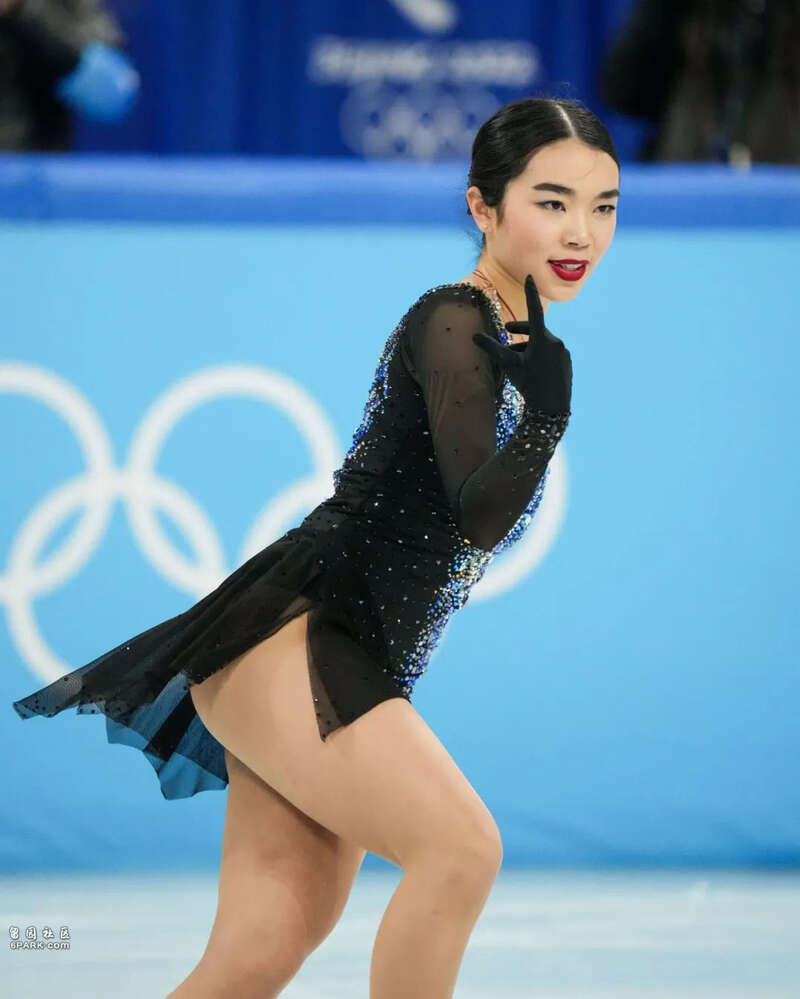
陈楷雯在北京奥运会团体赛女子短节目比赛中获得第五名。GABRIELA BHASKAR/THE NEW YORK TIMES
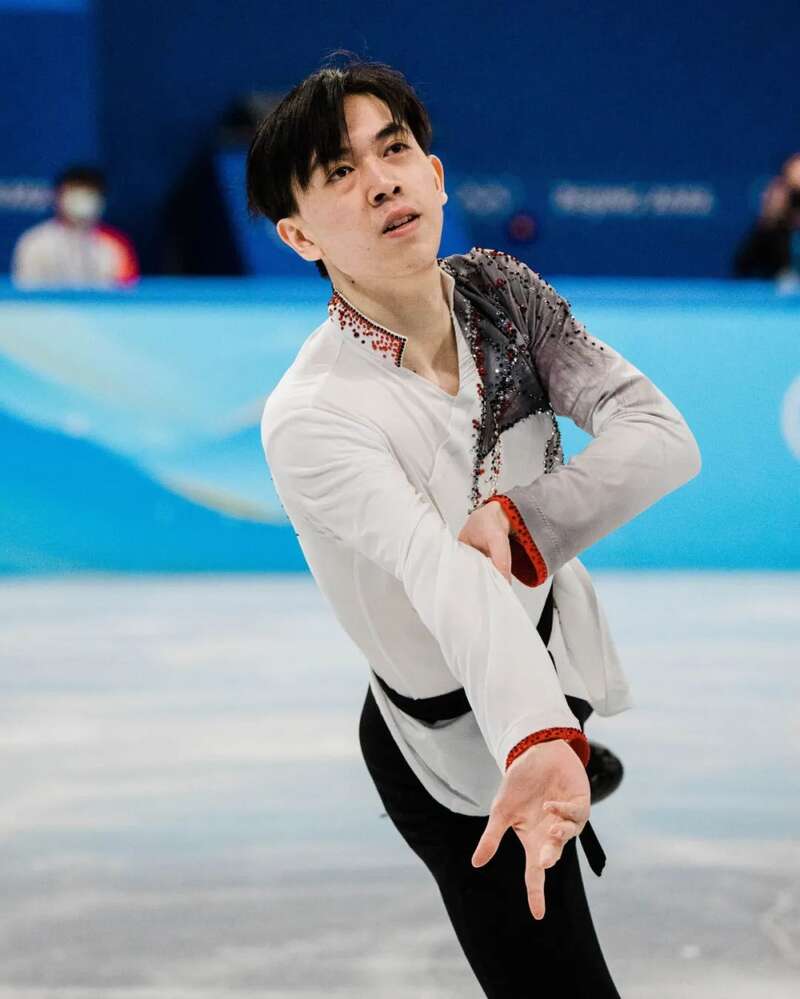
周知方参加了北京奥运会团体赛男子自由滑冰项目的比赛。美国队获得银牌。GABRIELA BHASKAR/THE NEW YORK TIMES
Zhou, who had to withdraw from the Games on Monday after testing positive for the coronavirus, has skated exhibition performances to the music of Joji, a pop singer from Japan, and last week skated in the team event to the theme from the 2000 Ang Lee film “Crouching Tiger, Hidden Dragon.”
本周一因新冠病毒检测呈阳性而不得不退出奥运会的周知方选择的曲目是日本流行歌手Joji的音乐。他在上周的团体项目的选曲是2000年李安电影《卧虎藏龙》的主题曲。
“Everybody is celebrating Chinese New Year right now,” Zhou said. “It’s the Year of the Tiger, and I was born in the Year of the Dragon, so it’s kind of perfect.”
“现在每个人都在庆祝中国新年,”周知方说。“今年是虎年,而我是龙年出生的,所以很完美。”
As a group, these skaters have enjoyed a kind of hidden comfort zone on the team, a calmness afforded by not being the Only One.
作为一个团体,这些选手在团队中享受着一种隐藏的舒适区,自己不再是“唯一的亚裔”,从而得到了平静。
Zhou’s mother has become known for inviting the skaters over to her place for home cooking.
大家都知道周知方的母亲喜欢邀请其他选手到她家吃饭。
Karen Chen said she had meaningful conversations with Nathan Chen about managing the pressure and expectations of immigrant parents, about addressing mental health in a community in which it is not often prioritized. (Studies regularly show Asian Americans, as a racial group, are among the least likely in this country to seek mental health services.)
陈楷雯说,她与陈巍深入地讨论过如何处理移民父母带来的压力和期望,以及如何在一个通常不重视心理健康的群体里探讨心理健康问题。(研究经常表明,在美国,作为一个种族群体,亚裔美国人寻求心理健康服务的可能性是最低的。)
More lightheartedly, Karen Chen pointed out that all four Asian American singles skaters on the team spoke Mandarin, at varying levels of proficiency. She had been brushing up before arriving here.
还有一件轻松点的事,陈楷雯指出,队中的所有四名亚裔单人选手或多或少都会一些普通话。她在来参赛前一直在温习。
“I think Nathan’s Chinese is the worst,” she said, laughing. “I can say confidently that’s one thing I am better than Nathan at.”
“我认为陈巍的中文是最差的,”她笑着说。“我可以自信地说,至少这方面我总算是比他强的。”
